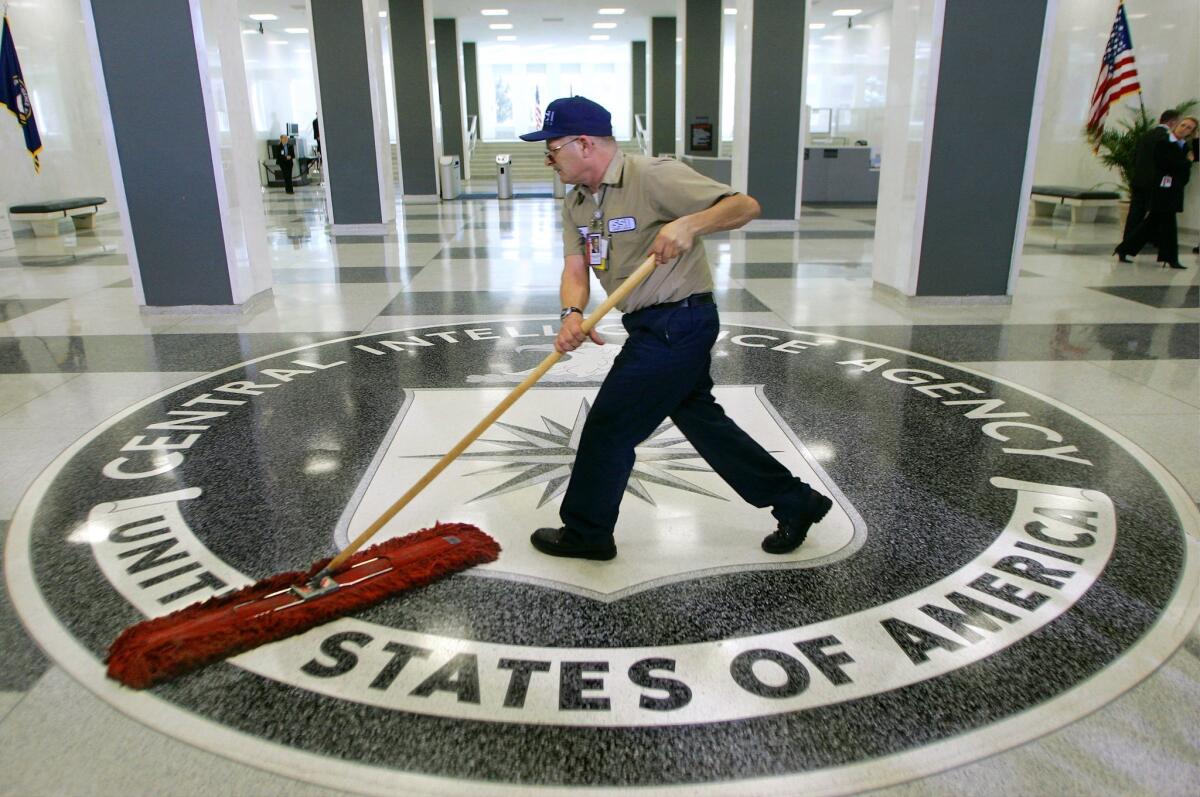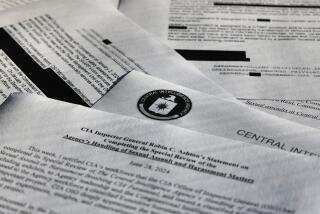CIA struggled to keep rationalizing brutal interrogations, report shows

Reporting from WASHINGTON — When CIA interrogators waterboarded their first prisoner, Al Qaeda operative Abu Zubaydah, on Aug. 4, 2002, they justified the simulated drowning as a vital tool to extract secrets about future attacks against the United States.
But after 20 days of round-the-clock interrogation at a secret prison in Thailand, during which Zubaydah was repeatedly waterboarded in long sessions, slammed against walls, slapped, confined in a coffin-size box for 266 hours and chained in “stress positions,” the interrogators concluded the Saudi-born operative knew nothing about new plots.
At that point, the justification changed: Officials said the brutal treatment was necessary not to extract information, but to reassure themselves that Zubaydah already had told them everything he knew.
“Our goal was to reach the stage where we have broken any will or ability of subject to resist,” the interrogators said in an email to CIA headquarters. The goal was to get to “the point that we could confidently assess” that Zubaydah did “not possess undisclosed threat information,” they said.
The shifting explanation for Zubaydah’s treatment, laid out in the 500-page summary of the Senate Intelligence Committee report made public Tuesday, provides an example of how the secret interrogation program from its inception became a self-justifying enterprise that slipped free of the constraints that top officials had promised would guide it.
After the Sept. 11, 2001, terrorism attacks, under intense demands to produce usable intelligence, the agency resorted to deception, manipulation and intellectual contortions to rationalize and continue using interrogation techniques that even some of its own officials worried amounted to illegal torture, the report documents.
In Zubaydah’s case, the sessions often left him crying, whimpering and compliant enough that a raised eyebrow and the snap of an interrogator’s finger were sufficient to get him to “lie flat” to be waterboarded. In one instance, he “became completely unresponsive,” bubbles rising from his water-filled mouth, until he was revived with medical treatment.
Inside the CIA headquarters, officials repeatedly pushed interrogators at secret detention facilities in Poland, Thailand, Afghanistan, Romania and elsewhere to intensify the harsh treatment, even after officers at the sites had concluded there was little more information to be gained from a prisoner.
Many of the agency interrogation teams included case officers with little or no experience and questionable backgrounds, including one with “workplace anger management issues” and another who “had reportedly admitted to sexual assault,” the report says.
CIA Director John Brennan said in a statement Tuesday that “we acknowledge that the detention and interrogation program had shortcomings and that the agency made mistakes.” He added that “the most serious problems occurred early on and stemmed from the fact that the agency was unprepared and lacked the core competencies required to carry out an unprecedented, worldwide program” of detention and interrogation.
One example of that lack of preparation cited in the report: The chief of interrogations, whose name was redacted, got the job even though he had been “orally admonished for inappropriate use of interrogation techniques” while conducting training in Latin America during the 1980s.
The interrogations chief became so disillusioned at the treatment of detainees that he sent an email to CIA colleagues in January 2003, calling the program a train wreck waiting to happen. “I intend to get the hell off the train,” he wrote, adding that he was “retiring shortly” because he no longer wanted to be associated with the program “in any way.”
His departure was in response to the interrogation of Abd al Rahim al Nashiri, a Saudi captured in Dubai in 2002 who was accused of involvement in the bombing of the U.S. destroyer Cole in Yemen in 2000 and the bombings of U.S. embassies in East Africa in 1998.
After questioning Nashiri in 2002 and waterboarding him at least three times, CIA interrogators concluded that he was “cooperative and truthful.” Officials at the CIA’s Alec Station, a headquarters unit responsible for intelligence on Al Qaeda, rejected that conclusion because Nashiri had not disclosed any information about future plots, the report says.
The headquarters officials sent an untrained interrogator to take over the questioning and “fix” the situation, the report says. He kept Nashiri in a “standing stress position” with his hands bound above his head for two and a half days. While Nashiri was blindfolded, a pistol was placed near his head and a drill was operated near his body.
Those techniques had not been authorized either by the CIA or by Justice Department officials who had ruled that the CIA’s interrogation practices would not violate U.S. laws against torture. The Justice Department rulings had been based in part on assurances that the program involved safeguards, but those were routinely violated, the committee said.
Two former military psychologists, James Mitchell and Bruce Jessen, who are identified in the report by pseudonyms, were the chief architects of the interrogation program and personally conducted some of the waterboarding, even though they “had no direct experience” with the practice, the report says. Their only experience was helping to run an Air Force program in the 1980s that trained pilots to resist interrogation they might face if captured by nations that did not observe the Geneva Convention against torture.
The CIA relied on the two men to assess the psychological effects of waterboarding and other techniques on individual prisoners. That put them in position to judge the effectiveness of interrogations they were involved in administering, the report noted.
A company the two formed to help run the program received $81 million from the CIA from 2002 to 2009, the Senate investigation found.
In January 2003, one of the psychologists arrived at the detention site where Nashiri was being held to assess whether he should be subjected to additional harsh interrogation measures. He recommended going ahead with “the full range of enhanced exploitation and interrogation measures” to establish a “desired level of helplessness,” the report says.
Nearly two years after the CIA’s last interrogation of Nashiri, an assessment by one of the psychologists who had recommended his harsh treatment concluded the prisoner had “provided essentially no actionable information.” In 2006, Nashiri was transferred to the U.S. military prison at Guantanamo.
In the weeks after the Sept. 11 attacks, when detaining prisoners was first discussed within the Bush administration, CIA officials promised their facilities would be comparable to federal prisons or would meet Pentagon standards for prisoners of war.
The facilities fell far short of those standards. In 2002, when officials from the U.S. Bureau of Prisons visited a CIA prison in Afghanistan known as the Salt Pit, they were stunned to find detainees shackled in their cells in complete darkness and isolation, with only buckets for human waste.
“They have never been in a facility where individuals are so sensory deprived,” a CIA officer wrote in an email.
The program grew so quickly that the agency had difficulty keeping track of all of its detainees. In December 2003, a CIA station chief in a country the report does not identify said: “We have made an unsettling discovery that we are holding a number of detainees about whom we know very little.” Most of the prisoners had not been questioned for months.
CIA officers involved in the program worried from the start that they might face criminal charges. Those concerns led Jose Rodriguez, the agency’s deputy director for operations, to seek written assurances from Atty. Gen. John Ashcroft that no one would face prosecution, a request Ashcroft denied.
Rodriguez also warned underlings against writing emails that raised questions about the legality of the interrogations. After one message in 2002 in which an interrogator wrote that the techniques they were using were “approaching the legal limit,” Rodriguez admonished him not to put such statements in writing.
“Such language is not helpful,” he wrote.
More to Read
Sign up for Essential California
The most important California stories and recommendations in your inbox every morning.
You may occasionally receive promotional content from the Los Angeles Times.











